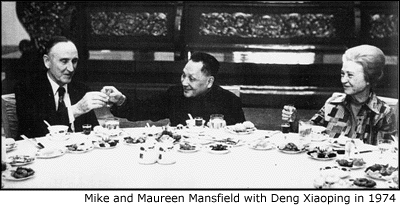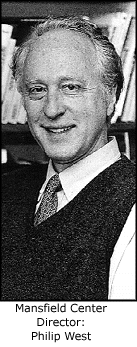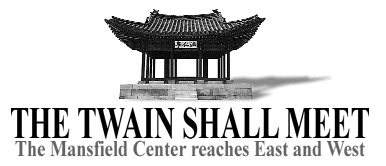WINTER 1998 Montanan - Volume 15, Number 2
by Patrick Hutchins
When Philip West met Mike Mansfield at the former senator's Washington, D. C. office, he wasn't first struck by the mementos of a life spent among presidents, prime ministers and pretenders. Rather it was a simple gesture of hospitality. "He doesn't send his secretary out to get coffee," West says. "He makes it for you himself."

West lets this small ritual of humility speak for the spirit of the ninety-four year old retired politician and former ambassador to Japan under Presidents Carter and Reagan. This same spirit guides the new director of the Maureen and Mike Mansfield Center at The University of Montana as he steers the center out of its recent period of turmoil. A tall, lanky man whose snow-moistened hiking boots seem entirely appropriate with his professorial tweeds on this bright winter morning, West looks as if he'd be as comfortable leaning down from a tractor or hefting a splitting maul as he is leading a classroom discussion.
West's strategy has been to unify the center's energies. Previously, the center represented defining characteristics of Mansfield: a passion for the peoples and cultures of Asia along with a desire to improve East/West relations and maintenance of the highest ethical standards in public life. Under West, the center is devoting itself to improving understanding and relations between the East and West, while letting an emphasis on high ethical standards inform its agenda without setting it. To accomplish this, West works hand-in-glove with the University's Asian Studies Program as the Mansfield Professor of Modern Asian Affairs while maintaining close contact with academic, governmental and business leaders across the Pacific Rim.
Yet he also is determined that the center doesn't become simply one more university think tank, churning out research reports of interest mainly to academics. Supported by the fifteen year old Maureen and Mike Mansfield Foundation, the center must serve its communities, both local and global.
Bringing Issues Home
The 1997 Mansfield Conference, "Creating Homes in American and Asian Environments," nicely illustrates the point. It's hard to imagine a theme that more directly impacts everyone, from the workers of the teeming Far East to Montanans who worry about overpopulation with every Bekins van that arrives from California.
A range of conference co-sponsors came out of the woodwork. Along with academics from UM's School of Forestry and Montana State University's School of Architecture, West rounded up business and community leaders not normally found at such conferences. Among the twenty co-sponsors, long-time area real estate agents and forest products producers joined groups like Women's Opportunity Resource Development and the Montana Environmental Information Center at the three-day event.
It was a practical, hands-on affair. Each of the keynote speakers explored the evolving western concept of home. Participants took part in seminars, toured demonstration homes built from alternative materials and learned about the "bioregion" movement, which advocates building homes reflective of the unique climate of geography and materials of a given area.

Jim Bowyer, director of the Forest Products Management Development Institute at the University of Minnesota, challenged environmentalists and developers alike to take responsibility for their consumption. "Jim Bowyer's a reality guy," says conference organizer Steve Loken, who has pioneered the use of recycled materials in new construction. "He says, 'Look, if you want all this stuff, it's got to come from somewhere.'"
Representing one of two Asian points of view was architect Itsuko Hasegawa, whose contemporary designs combine traditional Japanese ideas of natural harmony with the needs of population densities that most Montanans would find incomprehensible.
Yi-Fu Tuan, one of the most respected cultural geographers in the world, took an eloquent look at the idea of the home, as distinct from the houses we build. Tuan suggested that "pre-modern" homes - which saw every major life event from birth to death - were vastly different from the sanitized version that most Americans now prefer.
Conferences rarely solve the problems they raise. But Loken, for one, thinks the conference on creating homes made a good start. "The Mansfield Center's role in bringing all this together for discussion was a stroke of genius on Philip's part," he says. "The dialog was started... Whether or not common ground was achieved, I think connection definitely was."
Connecting Cultures
It is just this sort of connection-among people of different opinions and cultures-that the center has been working toward in its recent activities. In 1996, American and Chinese leaders gathered in Bigfork, Montana, for the first of a series of retreats. The retreats are small, informal gatherings designed to allow leaders on important issues to get to know one another. "When decisions are made in the future," says West, "people will be able to recall the hike they took together, the meals they shared." The second annual retreat, which focused on food security and world trade, was held in Beijing in 1997 and was attended by Senator Max Baucus and American Ambassador to China James Sasser, among others.
In a book due out this year, the center explores historical conflicts between Americans and Asians. America's Wars in Asia: A Cultural Approach to History and Memory, published by M.E. Sharpe, is a collection of essays by historians and writers that attempts to shed light on why so many Americans-and so many more Asians-have died fighting each other in the Pacific War, the Korean War and the Vietnam War.
Living and Dying in the New Millennium
West and his revitalized center aren't resting on their laurels. This October's conference, "The Healing Arts in American and Asian Cultures: Living and Dying Well," promises to address issues that touch us all. In the three-day conference, the center hopes to start a dialog about how we live and die-issues that will no doubt be uncomfortable to some. But, as people say, no one gets out of here alive.
The center has teamed up with author Dr. Ira Byock, founder of the Missoula Demonstration Project: The Quality of Life's End, director of UM's new Robert Wood Johnson Foundation and a national leader of the hospice movement. West has lined up psychiatrist Arthur Kleinman, a distinguished medical anthropologist from Harvard. West has also been busy wooing Bill Moyers, whose PBS series, "Healing," gave many of these same issues their first broad public airings a few years ago.

As we count down to the new millennium, the people at the Maureen and Mike Mansfield Center will continue working to broaden understanding between the people of America and Asia, which Mansfield thought was vital to the future of the West. "I have always seen our future unfolding in the Pacific Basin," he told an audience at UM on May 5, 1991. "It is there that we see today the most dynamic economic growth and opportunity in the world. It is there that we find great natural resources and great human resources."
West says he envisions "a day when an understanding and appreciation for the nations and peoples of Asia are more central in the discussions in the University, the public schools and the community at large."
And if, by chance, Bill Moyers does show up in Missoula in October, Philip West wants to be the first to brew him a cup of coffee.
A former tugboat cook, adobe brick maker and advertising copywriter, Patrick Hutchins now free-lances in Missoula.
M
